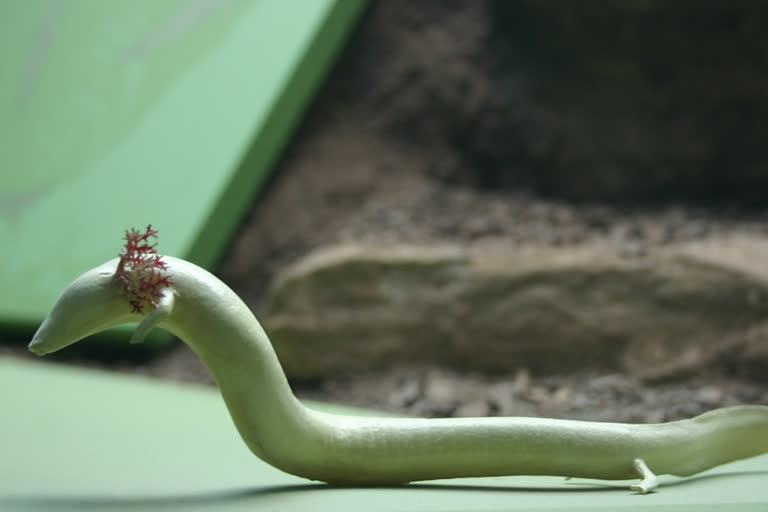Postojna: Meet the olms, the tiny blind, cave-dwelling creatures or Aquatic salamanders, to be precise. They have sensitive organs in the head to sense prey without ever seeing it.
Olms breathe using external gills and only grow up to 30 centimetres long. These tiny guys are already four-years-old.
The baby dragons can live for up to one hundred years old, go without eating for up to 12 years, and can regenerate limbs.
Tourists come to the limestone Postojna Cave in southern Slovenia for breathtaking views of stalagmites and stalactites and a train ride through the cave.
But now, they can also visit its mysterious baby cave dragons.
For the first time, the Postojna Cave is displaying three of the juvenile olms to the public in a new aquarium. The cave has a total of 21 babies from the same 2016 brood.
Cave management have introduced one special VIP tour a day that includes visiting the nursery aquarium, which is outside the usual tourism route.
Katarina Kanduc is a researcher and biologist working with the olms.
Read more: Female spacewalker journeys to bottom of the ocean
"It's a very good opportunity to monitor the process, and, of course we can tell the story to the visitors as well, which (who) are not familiar with the life in caves," she says.
In 2016, the mother laid 64 olm eggs in a large exhibition aquarium, scientists believe this was the first time humans ever witnessed an olm laying eggs.
Scientists say although one female can lay hundreds of eggs in her lifetime, statistically only two can expect to reach adulthood.
Twenty-one juveniles survived from this clutch, a much better survival rate than was expected.
"When it comes to research, we have limited amount of information, so not many people are doing this research. And, of course, you always have to choose which path you're going to take. Are you going to research the development, the morphological structure, the physiology?" says Kanduc.
"So, we had to choose because we have limited resources."
Postojna Cave was closed during Slovenia's coronavirus outbreak and reopened to visitors on 11 June.
The "Meet the Baby Dragons" tour will show three of the 21 baby olms living in a cave laboratory.
The number of visitors is limited to up to 30 per-day in a single tour group to avoid disturbing the olms, explains Postojna Cave CEO Marjan Batagelj.
Also read: Lord Rama takes on Chinese dragon, Taiwan News depiction goes viral
"It will be a VIP view, only 20-30 people a day, so we can somehow adopt olms to different environments because guests cause some, movements, some vibrations and because of that we are very careful as they are mystical beings who attract big number of people," he says.
Since 2016, special precautionary measures have been taken and huge efforts made to enable the baby olms to develop safely.
Biologists, for example, brought some 100 kilograms of sand from the subterranean river Pivka, which is the olms' home, and sterilized it before it was used.
The olm is a very rare salamander, endemic to the caves of southeastern Europe.
In Slovenia, the olm is called the human fish because of its almost translucent rose-pink skin colour.
The IUCN Red List of Threatened Species lists them as vulnerable.
"They spontaneously ask questions: how do they survive in their natural habitat? What do they eat? And if you try to explain they are really special creatures, that's very interesting with children who ask why people are not like that?" says Batagelj.
More than 200,000 hours of infrared camera video footage has been collected of the baby olms.
It's seen as a huge source of new information about the species and includes the first ever fully recorded olm limb regeneration.
Also read: US-born Bei Bei settles into new Chinese home
(With inputs from AP)



